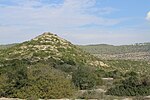Bayt 'Itab

Bayt ʿIṭāb (Arabic: بيت عطاب) was a Palestinian Arab village located in the Jerusalem Subdistrict. The village is believed to have been inhabited since the biblical period. An ancient tunnel which led to the village spring is associated with the story of Samson. Both during and after its incorporation into Crusader fiefdoms in the 12th century, its population was Arab. Sheikhs from the Lahham family clan, who were associated with the Qays tribo-political faction, ruled the village during Ottoman era. In the 19th century, this clan controlled 24 villages in the vicinity. The homes were built of stone. The local farmers cultivated cereals, fruit trees and olive groves and some engaged in livestock breeding. After a military assault on Bayt ʿIṭāb by Israeli forces in October 1948, the village was depopulated and demolished. Many of the villagers had fled to refugee camps in the West Bank less than 20 kilometres (12 mi) from the village. In 1950, an Israeli moshav, Nes Harim, was established north of the built up portion of Bayt 'Itab, on an adjacent peak.
Excerpt from the Wikipedia article Bayt 'Itab (License: CC BY-SA 3.0, Authors, Images).Bayt 'Itab
Halamit, Mate Yehuda Regional Council
Geographical coordinates (GPS) Address External links Nearby Places Show on map
Geographical coordinates (GPS)
| Latitude | Longitude |
|---|---|
| N 31.735 ° | E 35.053055555556 ° |
Address
בית עיטאב
Halamit
9987500 Mate Yehuda Regional Council
Jerusalem District, Israel
Open on Google Maps










